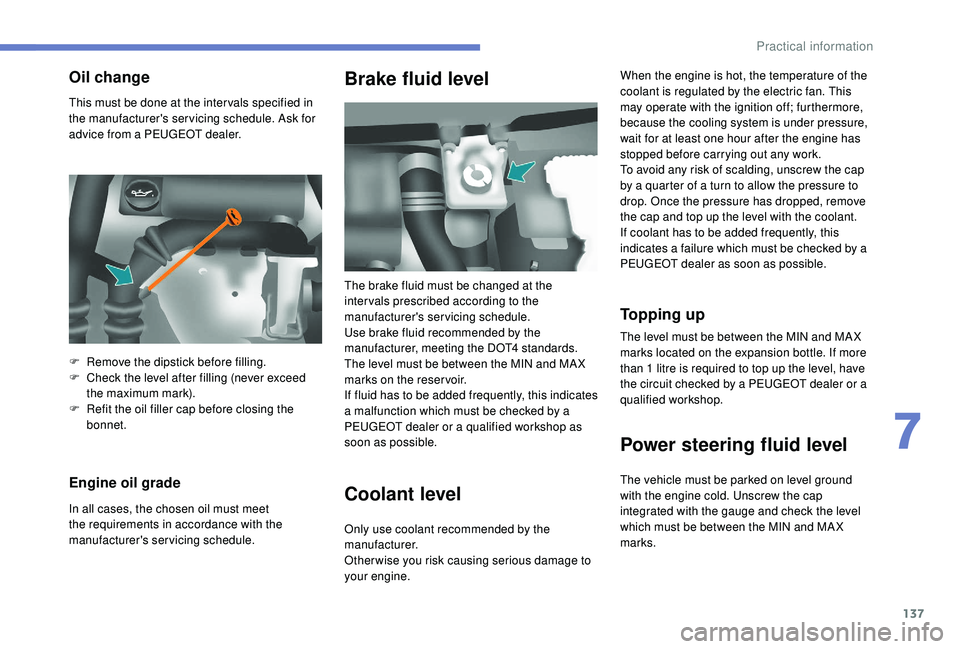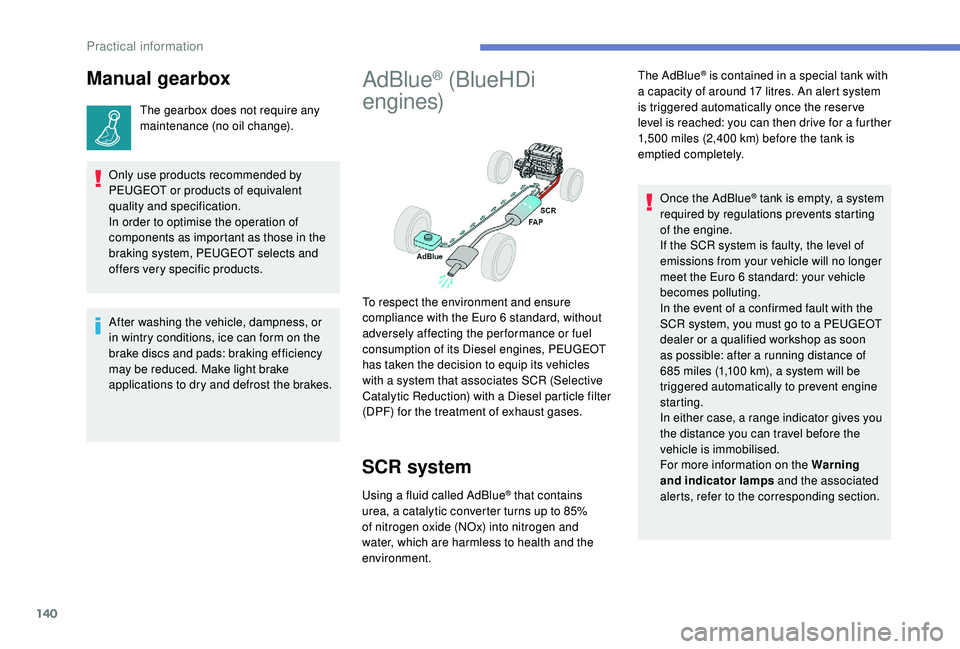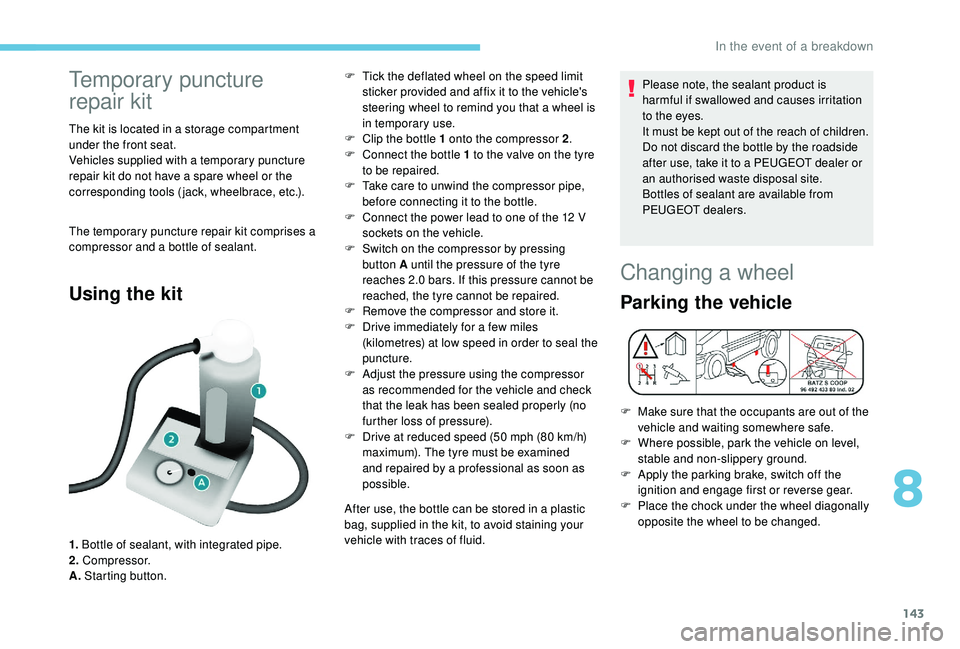2020 PEUGEOT PARTNER TEPEE brake fluid
[x] Cancel search: brake fluidPage 11 of 216

9
Warning/indicator lampStateCause Action/Observations
Red warning/indicator lamps
STOPFixed, associated with
another warning lamp
and accompanied
by a message in the
screen. Major faults linked with the "Brake
fluid level", "Engine oil pressure
and temperature", "Engine
coolant temperature", "Electronic
brake force distribution" and
"Power steering" warning lamps. You must stop as soon as it is safe to do so.
Park, switch off the ignition and call a PEUGEOT
dealer or qualified workshop.
Engine coolant
temperature and
level Fixed, with the needle
in the red zone.
An abnormal increase in
temperature.
Park and switch off the ignition, then allow to cool down.
Check the level visually.
Flashing.
A drop in the engine coolant level. Contact a PEUGEOT dealer or a qualified workshop.
Engine oil pressure
and temperature Fixed while driving. Insufficient pressure or excessive
temperature.
Park and switch off the ignition, then allow to cool down.
Check the level visually. For more information on
Checking levels, refer to the corresponding section.
Fixed, even though the
level is correct. A major fault.
Have it checked by a PEUGEOT dealer or a qualified
workshop.
Battery charge Fixed. A fault in the charging circuit. Check the battery terminals. For more information on
the Battery, refer to the corresponding section.
Flashing. Active functions set to standby
(economy mode). For more information on the Battery
, refer to the
corresponding section.
Fixed, despite the
checks. A fault with the ignition or
injection system. Have it checked by a PEUGEOT dealer or a qualified
workshop.
1
Instruments
Page 12 of 216

10
Warning/indicator lampStateCause Action/Observations
Seat belt not
fastened Fixed, then flashing.
The driver and/or front passenger
has not fastened their seat belt. Pull the strap then insert the tongue in the buckle.
Accompanied by an
audible signal, then
fixed. The vehicle is moving with the
driver's and/or front passenger’s
seat belt unfastened. Check that the seat belt is fastened correctly by pulling
the strap.
Power steering Fixed. The power steering has a fault. The vehicle retains conventional steering without
assistance.
Have it checked by a PEUGEOT dealer or a qualified
workshop.
Opening detection Fixed, accompanied
by a message in the
screen. One of the vehicle access
openings is not properly closed.
Check that all the vehicle access openings are
properly closed.
Parking brake Fixed. The parking brake is applied or
not properly released. Release the parking brake to switch off the warning
lamp, keeping your foot on the brake pedal.
Brake fluid level Fixed. The fluid level is too low. Top up with a fluid approved by PEUGEOT.
+ Electronic brake
force distribution
Fixed, even though
the level is correct,
associated with the
ABS
warning lamp. There is a fault with the system.
You must stop as soon as it is safe to do so.
Park and switch off the ignition.
Contact a PEUGEOT dealer or a qualified
workshop.
Instruments
Page 138 of 216

136
Engines
Petrol
Diesel
Take care during any work under the bonnet.7.
Engine oil filler cap.
8. Power steering fluid reservoir.
9. Priming pump (except BlueHDi engine).
Battery connections:
Checking levels
Check all of these levels regularly, in line
with the manufacturer's servicing schedule.
Top them up if necessary, unless other wise
indicated.
If a level drops significantly, have the
corresponding system checked by a PEUGEOT
dealer or a qualified workshop. If you have to remove/refit the engine
cover, handle it with care to avoid
damaging the fixing clips.
Used products
Avoid prolonged contact of used oil or
fluids with the skin.
Most of these fluids are harmful to health
or indeed very corrosive. Do not discard used oil or fluids into
sewers or onto the ground.
Take used oil to a PEUGEOT dealer or
a qualified workshop and dispose of it in
the containers reser ved for this purpose.
Oil level
It is recommended that you check the oil every
3,000
miles (5,000 km) and that you top it up
between two oil changes, if necessary.
Check the level with the vehicle level, engine
cold, using the dipstick.
Dipstick
1. Front screenwash fluid reser voir.
2. Fusebox.
3. Engine coolant reservoir.
4. Brake and clutch fluid reser voir.
5. A i r f i l t e r.
6. Dipstick. +
Positive terminal.
- Negative terminal (earth).
2 marks on the dipstick:
A = maximum
If you fill past this mark, consult
a PEUGEOT dealer or a qualified
workshop. An excess of oil could
cause engine damage.
B = minimum
If this mark is not reached, top up the level
through the oil filler cap, using the type of oil
approved for your engine.
Never allow the level to fall below this mark.
To maintain the reliability of engines and
emission control systems, the use of additives
in engine oil is prohibited.
Practical information
Page 139 of 216

137
This must be done at the inter vals specified in
the manufacturer's servicing schedule. Ask for
advice from a PEUGEOT dealer.
Engine oil grade
In all cases, the chosen oil must meet
the requirements in accordance with the
manufacturer's servicing schedule.
Brake fluid level
Coolant levelWhen the engine is hot, the temperature of the
coolant is regulated by the electric fan. This
may operate with the ignition off; furthermore,
because the cooling system is under pressure,
wait for at least one hour after the engine has
stopped before carrying out any work.
To avoid any risk of scalding, unscrew the cap
by a quarter of a turn to allow the pressure to
drop. Once the pressure has dropped, remove
the cap and top up the level with the coolant.
If coolant has to be added frequently, this
indicates a failure which must be checked by a
PEUGEOT dealer as soon as possible.
To p p i n g u p
Oil change
The brake fluid must be changed at the
inter vals prescribed according to the
manufacturer's servicing schedule.
Use brake fluid recommended by the
manufacturer, meeting the DOT4 standards.
The level must be between the MIN and MA X
marks on the reservoir.
If fluid has to be added frequently, this indicates
a malfunction which must be checked by a
PEUGEOT dealer or a qualified workshop as
soon as possible.
Only use coolant recommended by the
manufacturer.
Otherwise you risk causing serious damage to
your engine.
F
R
emove the dipstick before filling.
F
C
heck the level after filling (never exceed
the maximum mark).
F
R
efit the oil filler cap before closing the
bonnet. The level must be between the MIN and MA X
marks located on the expansion bottle. If more
than 1
litre is required to top up the level, have
the circuit checked by a PEUGEOT dealer or a
qualified workshop.
Power steering fluid level
The vehicle must be parked on level ground
with the engine cold. Unscrew the cap
integrated with the gauge and check the level
which must be between the MIN and MA X
marks.
7
Practical information
Page 140 of 216

138
Screenwash fluid level
For optimal cleaning quality and safety, we
recommend that you use the PEUGEOT range
of products.
For optimum cleaning and to avoid freezing,
this fluid must not be topped up or replaced
with plain water.
Capacity of the screenwash reser voir:
approximately 3
litres.
Diesel additive level (Diesel
engine with particle filter)
A low additive level is indicated by
illumination of the Ser vice warning
lamp, accompanied by an audible
warning and a message on the screen.
If the message is still displayed and the Ser vice
warning lamp remains lit, consult a PEUGEOT
dealer or a qualified workshop.
To p p i n g u p
This additive must be topped up without delay
by a PEUGEOT dealer or a qualified workshop.
Checks
Battery
The battery does not require any
maintenance.
However, check regularly that the
terminals are correctly tightened
(versions without quick release
terminals) and that the connections
are clean.
Versions equipped with Stop & Start are
fitted with a 12
V lead-acid battery of
specific technology and specification.
Its replacement should be carried out
only by a PEUGEOT dealer or a qualified
workshop.
Brake pads
Brake wear depends on the style
of driving, particularly in the case
of vehicles used in town, over short
distances. It may be necessary to
have the condition of the brakes
checked, even between vehicle
services.
Unless there is a leak in the circuit, a drop in
the brake fluid level indicates that the brake
pads are worn.
Brake disc/drum wear
For information on checking
brake disc/drum wear, contact a
PEUGEOT dealer or a qualified
workshop.
Parking brake
If excessive travel or a loss of
effectiveness of this system is
noticed, the parking brake must
be checked, even between two
services.
This system must be checked by a PEUGEOT
dealer or a qualified workshop.
Once the engine is started, this signals that
the particle filter is starting to saturate (in
conditions of urban driving of exceptionally long
duration: low speeds, traffic jams, etc.).
To regenerate the filter, you are advised to
drive as soon as possible, as traffic conditions
allow, at a speed of at least 37
mph (around
60
km/h) for at least five minutes (until the
Ser vice warning lamp goes off and the
message disappears).
Relay noises may be heard under the
dashboard during regeneration of the particle
f i l t e r. At the start of winter, have your battery checked
by a PEUGEOT dealer or a qualified workshop.
Practical information
Page 142 of 216

140
Manual gearbox
The gearbox does not require any
maintenance (no oil change).
Only use products recommended by
PEUGEOT or products of equivalent
quality and specification.
In order to optimise the operation of
components as important as those in the
braking system, PEUGEOT selects and
offers very specific products.
AdBlue® (BlueHDi
engines)
SCR system
Using a fluid called AdBlue® that contains
urea, a catalytic converter turns up to 85%
of nitrogen oxide (NOx) into nitrogen and
water, which are harmless to health and the
environment. The AdBlue
® is contained in a special tank with
a capacity of around 17 litres. An alert system
is triggered automatically once the reser ve
level is reached: you can then drive for a further
1,500
miles (2,400 km) before the tank is
emptied completely.
To respect the environment and ensure
compliance with the Euro 6 standard, without
adversely affecting the per formance or fuel
consumption of its Diesel engines, PEUGEOT
has taken the decision to equip its vehicles
with a system that associates SCR (Selective
Catalytic Reduction) with a Diesel particle filter
(DPF) for the treatment of exhaust gases. Once the AdBlue
® tank is empty, a system
r
equired by regulations prevents starting
of the engine.
If the SCR
system is faulty, the level of
emissions from your vehicle will no longer
meet the Euro 6 standard: your vehicle
becomes polluting.
In the event of a confirmed fault with the
SCR system, you must go to a PEUGEOT
dealer or a qualified workshop as soon
as possible: after a running distance of
685
miles (1,100
km), a system will be
triggered automatically to prevent engine
starting.
In either case, a range indicator gives you
the distance you can travel before the
vehicle is immobilised.
For more information on the Warning
and indicator lamps and the associated
alerts, refer to the corresponding section.
After washing the vehicle, dampness, or
in wintry conditions, ice can form on the
brake discs and pads: braking efficiency
may be reduced. Make light brake
applications to dry and defrost the brakes.
Practical information
Page 145 of 216

143
Temporary puncture
repair kit
The kit is located in a storage compartment
under the front seat.
Vehicles supplied with a temporary puncture
repair kit do not have a spare wheel or the
corresponding tools ( jack, wheelbrace, etc.).
The temporary puncture repair kit comprises a
compressor and a bottle of sealant.
Using the kit
1. Bottle of sealant, with integrated pipe.
2. Compressor.
A. Starting button. F
T
ick the deflated wheel on the speed limit
sticker provided and affix it to the vehicle's
steering wheel to remind you that a wheel is
in temporary use.
F
C
lip the bottle 1 onto the compressor 2
.
F
C
onnect the bottle 1 to the valve on the tyre
to be repaired.
F
T
ake care to unwind the compressor pipe,
before connecting it to the bottle.
F
C
onnect the power lead to one of the 12 V
sockets on the vehicle.
F
S
witch on the compressor by pressing
button A until the pressure of the tyre
reaches 2.0 bars. If this pressure cannot be
reached, the tyre cannot be repaired.
F
R
emove the compressor and store it.
F
D
rive immediately for a few miles
(kilometres) at low speed in order to seal the
puncture.
F
A
djust the pressure using the compressor
as recommended for the vehicle and check
that the leak has been sealed properly (no
further loss of pressure).
F
D
rive at reduced speed (50 mph (80 km/h)
maximum). The tyre must be examined
and repaired by a professional as soon as
possible.
After use, the bottle can be stored in a plastic
bag, supplied in the kit, to avoid staining your
vehicle with traces of fluid. Please note, the sealant product is
harmful if swallowed and causes irritation
to the eyes.
It must be kept out of the reach of children.
Do not discard the bottle by the roadside
after use, take it to a PEUGEOT dealer or
an authorised waste disposal site.
Bottles of sealant are available from
PEUGEOT dealers.
Changing a wheel
Parking the vehicle
F Make sure that the occupants are out of the
vehicle and waiting somewhere safe.
F
W
here possible, park the vehicle on level,
stable and non-slippery ground.
F
A
pply the parking brake, switch off the
ignition and engage first or reverse gear.
F
P
lace the chock under the wheel diagonally
opposite the wheel to be changed.
8
In the event of a breakdown
Page 209 of 216

175
AAccessories ..................................... 76, 13 4 -13 5
Active City Brake ............................... .....120 -121
AdBlue
® ............................................ 13, 140 -141
Adjusting seat ................................................. 38
Adjusting the date
........................................... 24
Adjusting the time
..................................... 23 -24
Advanced Grip Control
................................... 80
Advice on driving
.................................. 103 -104
Airbags
...............................
.......................85, 90
Airbags, curtain
......................................... 87- 8 8
Airbags, front ...................................... 86, 88 , 91
Airbags, lateral
.......................................... 86, 88
Air conditioning, automatic
.............................69
Air conditioning, manual
................................. 69
A
nti-lock braking system (ABS) ......................79
Anti-pinch
........................................................ 36
A
nti-slip regulation (ASR)
............................... 12
Apple CarPlay connection
.............................. 13
Armrest
................
...................................... 38-39
Assistance call
...............................
............7 7-78
Audio streaming (Bluetooth)
.......................10, 6
BBattery ................................................... 13 8, 15 8
Battery, remote control ...................................27
Blanking screen (snow shield)
......................13 0
BlueHDi
........................................... 21, 140 , 160
Bluetooth (hands-free)
....................... 1
4 -16, 6-8
Bluetooth (telephone)
................................. 1
4 -16
Bonnet
........................................................... 13 5
Boot lid
...................................................... 29-30
Brake discs
............................................ 13 8, 140
Brakes
................................................... 13 8, 140
Bulbs (changing)
.................................... 14 9 -15 0
CCab, crew ............................... ...................50-52
Cable, audio ...................................................... 9
Cable, Jack
....................................................... 9
Cartridge, fragrance
....................................... 58
CD
..................................................................... 5
CD, MP3
........................................................ 5-6
Central locking
.......................................... 33
-34
Changing a bulb
..................................... 1
4 9 -15 0
Changing a wiper blade
......................... 13
0 -131
Changing the remote control battery
..............26
Checking the levels
....................................... 13 6
Checks
................................................... 13 6 -14 0
Checks, routine
...................................... 13 8 -14 0
Child lock
................................................. 36, 102
Child seats
..................... 84,
89-90, 94-95 , 101
Child seats, conventional
................................94
Connection, Bluetooth
............................... 1
4 -16
Connection, MirrorLink
...................................12
Control, electric windows
................................36
Control, emergency door
................................ 29
C
ontrol, heated seats
...................................... 39
Control stalk, lighting
..........................15, 71 , 73
Control stalk, wipers
.................................. 7
3 -74
Courtesy lamp, front
....................................... 55
Cover, load space
............................... 60, 62- 63
Cruise control
......................................... 117-12 0
DDAB (Digital Audio
Broadcasting) - Digital radio ....................... 8
-9
Date (setting)
................................................... 24
Daytime running lamps, LED
..........................72
Deactivating the passenger's front airbag
....................................... 86, 90 -91
Dimensions
..............................
......169, 171-173
Direction indicators
......................................... 15
Display screen, instrument panel
.................108
Doors, rear
................................................ 30-32
Doors, side ............................... .................28-29
Doors, side-hinged ................................... 3
0-32
Driving abroad ................................................. 73
EElectric windows ............................................. 35
Electronic brake force distribution (EBFD) .....79
Electronic stability control (ESC)
........12,
79-80
Emergency braking assistance (EBA)
............79
Emergency call
.......................................... 7 7-78
Emissions control system, SCR
.............14, 140
Engine
........................................................... 13 6
Engine, Diesel
............................................... 128
Engine, petrol
...............................
.................128
Engines
......................................................... 161
FFilling the fuel tank ................................12 6, 128
Filter, air ........................................................ 13 8
Filter, oil
................
.................................. 13 8 -13 9
Filter, passenger compartment
.....................13 8
Fittings, front
................................................... 55
Fittings, interior
......................................... 5
4-56
Fittings, rear
.................................................... 60
Flap, fuel filler
................................................ 126
Fluid, brake
................................................... 13 6
Fluid, engine coolant
..................................... 13 6
Fluid, power steering
.................................... 13
6
Foglamps, front
............................................... 73
Fragrance diffuser ..................................... 57- 5 9
Frequency (radio)
........................................... 7- 8
Fuel ................................................................ 128
.
Alphabetical index